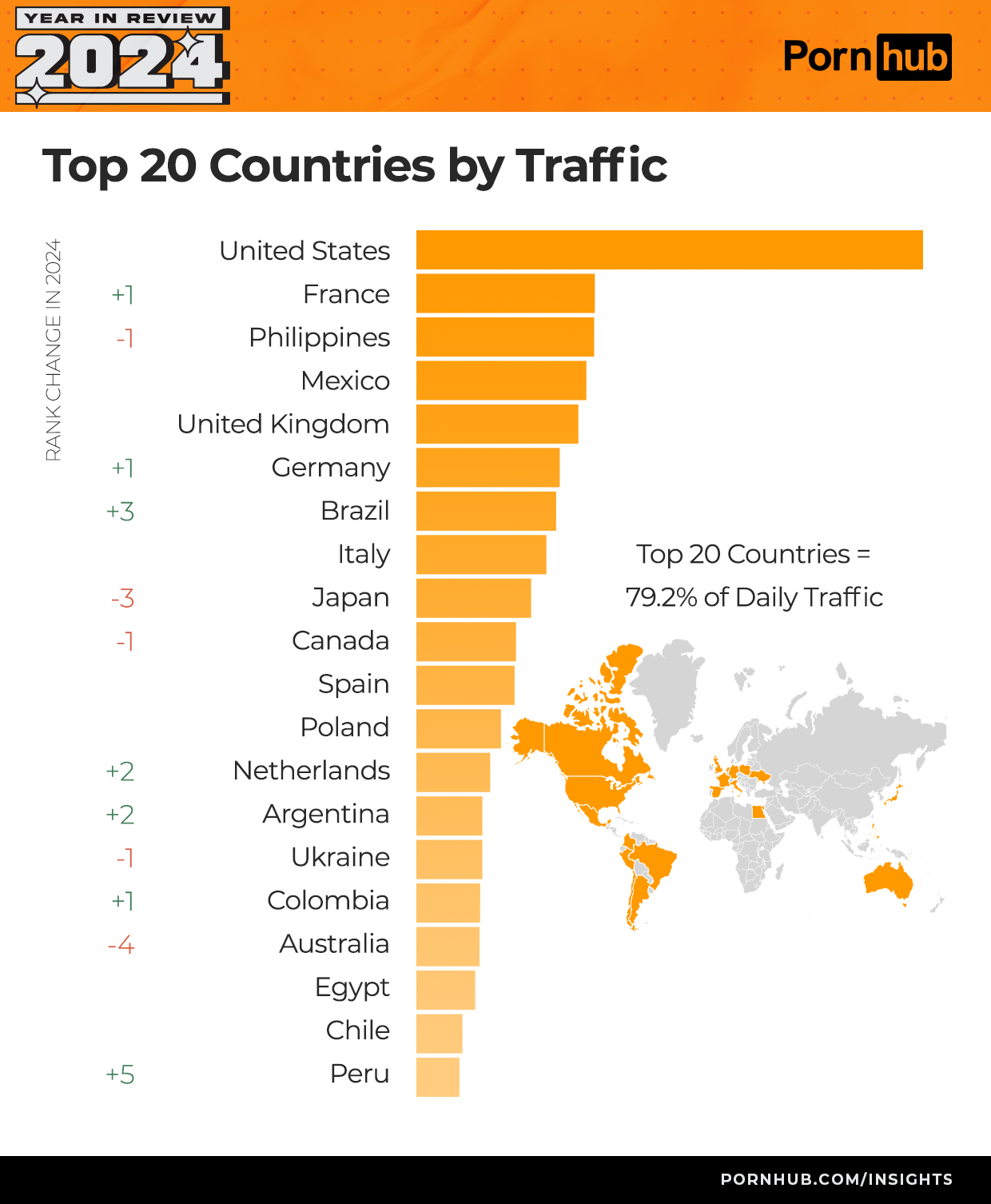🐰 TL;DR
Pornography in the Philippines reflects the tension between public modesty and private curiosity, shaped by uneven access to sexual education and enduring social taboos.
- The country ranks high globally for online adult content traffic.
- Porn often acts as de facto sex education, often setting unrealistic expectations.
- Cultural factors like religion and hiya (shame) drive consumption into secrecy.
- Better sexual literacy requires open conversations and accurate information.
Filipinos don’t always talk about sex, but online viewing habits reveal a different reality. Despite being one of Asia’s most conservative and religious countries, pornography in the Philippines quietly thrives. In 2024, the country took the third spot among a list of countries that visited the website Pornhub. Millions stream and search from the privacy of their devices, curious about what they cannot openly discuss.
This contradiction defines modern Filipino sexuality: public modesty clashing with private curiosity. It reflects how the country navigates conversations about pleasure and intimacy.
Today, pornography raises questions of education, representation, and control. What are Filipinos learning from what they see, and how does it shape their understanding of sex, consent, and relationships in a culture that still struggles with open dialogue?
Pornography Consumption in the Philippines
Filipinos rank among the top 20 nations for online adult traffic, spending more time per visit than almost anyone else. Mobile phones drive most of this activity, making adult content accessible anywhere, anytime.

The Most-Viewed and Most-Searched
Filipino viewing habits are complex, blending local curiosity with a massive appetite for foreign and animated content.
The most searched terms are “Pinay” and “Pinoy,” showing a strong preference for native content that feels relatable. However, the dominant viewing categories are Hentai (which ranks #1) and Japanese, followed closely by Reality and Asian content. Filipinos also view the Romantic category 110% more than the global average.
This dual preference suggests that while viewers seek connection through local and emotional themes, the highest consumption volume comes from highly stylized, non-native genres. Women are also increasingly part of this audience, shifting the once male-dominated space toward shared curiosity and couple viewing.
Porn as Education (and Mis-Education)
Without comprehensive sexuality education (CSE) in most schools, many Filipinos turn to porn for information. The problem? Porn rarely teaches consent, communication, or emotional intimacy. For younger audiences, it can set unrealistic expectations of what sex should look or feel like.
From Private Browsing to Public Platforms
Porn access isn’t limited to dedicated sites anymore. Softcore and suggestive content now circulate on social platforms like Twitter (X), Reddit, and Telegram. These “gray areas” of online behavior show how viewers can blend mainstream and adult spaces.
Hashtags like “afterdarkph” or “pinayleaks” are used to categorize content, often involving explicit or sensitive material, and their presence highlights significant issues around content regulation and online safety in the Philippines.
4 Cultural Factors Influencing How Filipinos View and Consume Porn
Pornography offers Filipinos an outlet to explore what society rarely allows them to discuss. But every click reveals the cultural and emotional forces shaping how people understand sex, identity, and morality.
1. Religion shapes moral boundaries
Catholic teachings dominate the country’s social fabric, defining what’s acceptable in both public and private life. Many Filipinos grow up viewing sex as something tied to sin rather than self-awareness.
This creates internal conflict: people want to learn, but they’re afraid of being judged for it. Porn becomes a private space where curiosity feels safer, even if the lessons it offers are incomplete.
2. “Hiya” reinforces silence
The cultural value of hiya (roughly translated as shame or embarrassment) discourages open discussions about anything sexual. Women, in particular, are expected to appear modest and pure, while men are pressured to act experienced and dominant.
Both struggle with unrealistic expectations. This silence pushes people to learn through secrecy, reinforcing misinformation and emotional distance.
3. Pop culture filters desire through morality and humor
Philippine media typically reshapes sex to fit social comfort zones. Films and TV often present intimacy as either moral consequence, comic relief, or background to romance. Scenes that suggest sexuality are softened with humor or blurred by metaphor.
Even online, discussions about sex gain traction only when disguised as entertainment. This pattern reflects how society negotiates discomfort: acknowledging desire, but only in ways that feel safe or indirect.
4. Digital spaces are reshaping the conversation
While stigma remains, online platforms are slowly changing how people talk about sex. Social media has given rise to sex educators, advocates, and anonymous communities discussing consent, pleasure, and safety without shame.
These spaces don’t erase taboo, but they open a dialogue that’s been missing for decades. Each small conversation chips away at cultural guilt, allowing curiosity to evolve into understanding.
Changing Attitudes toward Sex: Literacy and Healthy Curiosity
Conversations around pornography and sexual health remain limited, but several efforts could help shape a more informed understanding of both. Sexual literacy grows when curiosity is guided by accurate information. It begins with credible discussions about consent, communication, and pleasure.
Government efforts toward sexual education
In recent years, the Philippine government has begun taking more visible steps to improve sexual education. The Responsible Parenthood and Reproductive Health (RPRH) Act of 2012 requires age-appropriate sexuality education in schools, while the Department of Education (DepEd) has since introduced a Comprehensive Sexuality Education (CSE) framework with support from the United Nations Population Fund (UNFPA).
However, implementation remains inconsistent. Many schools still face barriers such as limited teacher training, cultural resistance, and lack of materials. As a result, while policy progress is clear, coverage is far from nationwide. For many students, formal education on topics like consent, reproductive health, and relationships still depends on where they study or who teaches them.
Openness begins with small conversations
When families, schools, and communities treat sexual health as education instead of shame, curiosity stops being a secret. The more Filipinos learn to talk about desire and boundaries, the less control guilt and taboo have over them.
Grassroots advocates are filling the gap
Local organizations like Likhaan Center for Women’s Health and Roots of Health are creating materials and workshops that focus on body literacy, safe sex, and reproductive rights.
Online, independent educators and healthcare workers use TikTok, Instagram, and X (Twitter) to explain topics once considered off-limits: STI prevention, contraception, even how to talk to partners.
Healthy curiosity starts with safer exploration
When people understand their bodies, communication, and boundaries, curiosity turns into something useful. It becomes a way to learn what feels safe and respectful instead of something to hide or feel guilty about.
- Informed adults use porn for preference, not education.
- Partners talk openly about comfort and consent.
- Communities learn to separate fantasy from real intimacy.
For those exploring their sexuality privately, safe and inclusive adult stores can support that journey. Platforms like Pink Bunny focus on body-safe products that promote consent and self-awareness, removing the secrecy often tied to sexual exploration.
Bringing the Conversation Home
In a society still learning to talk openly about pleasure and consent, honest education can help turn secrecy into self-awareness. Exploring sexuality safely starts with reliable information and tools that encourage comfort instead of shame.
Pink Bunny is a reputable adult shop that offers a welcoming space for this kind of exploration. We have a wide selection of products, from various vibrator sex toys to designer dildos designed for safety and quality. With free delivery for orders over ₱1,490, same-day service within NCR, cash on delivery, and discreet packaging, we make it easy to explore intimacy on your own terms.
Visit our branches in Makati, Angeles, and Cebu, or shop online anytime for peace of mind and privacy!
For inquiries or recommendations, reach out to 0928 382 8623 on WhatsApp or Viber to get personalized help anytime!
FAQs About Pornography in the Philippines
Pornography is widely consumed across the country, with the Philippines ranking among the top global visitors to major adult sites like Pornhub. Most traffic comes from mobile devices, making adult content easily accessible anywhere.
Cultural and religious norms discourage open discussions about sex, so many Filipinos turn to pornography to explore curiosity privately. It often becomes an informal substitute for the lack of comprehensive sex education.
While local terms like “Pinay” are most searched, the most-viewed categories are dominated by Hentai (#1) and Japanese content. Filipinos also show a strong preference for the Romantic category.
Pornography exists in a legal gray area. The Revised Penal Code (Article 201) prohibits the production and distribution of obscene materials, while RA 9775 and RA 11930 target child pornography and online sexual exploitation. Private adult viewing, however, is rarely monitored or prosecuted.
Pornography in the Philippines reflects deeper tensions around sex, morality, and identity. It exposes gaps in education and communication while sparking slow, ongoing conversations about consent, pleasure, and representation.




